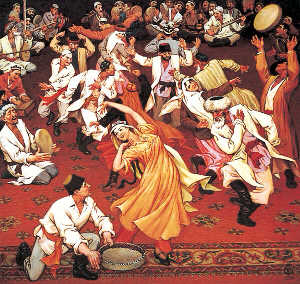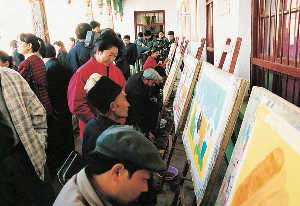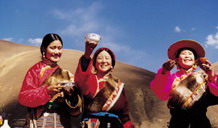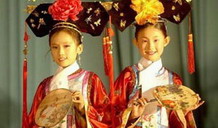Fine Arts
 Xinjiang, the ancient Xiyu (Western Regions), lying at the heart of Central Asia, has a rich store of paintings. Although the names of the artists who created the magnificent frescoes in Xinjiang are not yet known, they have left behind a cherished artistic legacy, and their originality has been diligently emulated. Their genius, giving rise to the long-standing tradition of the Western Regions painting, stands as an inspiration to generations that have followed.
Xinjiang, the ancient Xiyu (Western Regions), lying at the heart of Central Asia, has a rich store of paintings. Although the names of the artists who created the magnificent frescoes in Xinjiang are not yet known, they have left behind a cherished artistic legacy, and their originality has been diligently emulated. Their genius, giving rise to the long-standing tradition of the Western Regions painting, stands as an inspiration to generations that have followed.
The painting arts and techniques of Yuchi Yiseng and his father, born in the Western Regions during the Tang dynasty (618-907), were on par with those of Gu Kaizhi and Yan Liben, two of the most famous painters of ancient China. The history of Chinese art and painting includes Chinese artists from different ethnic groups. Ancient Buddhist paintings, modern Islamic ornaments and architecture, together with the interaction between the Eastern and Western cultures, have made the Western Regions painting a unique facet of the development of Chinese culture.
 Before 1949, artists from inland China such as Zhao Wangyun, Han Leran and Situ Qiao went to Xinjiang to collect materials and gather on-site experience, planting the seeds of modern painting arts at the same time. After the founding of New China, the fine arts of Xinjiang developed rapidly. The oil painting, made by Lie Yang in 1954, won rave reviews for its pioneering style. From the beginning of the early 1960s, with the influx of various artists from the inland into Xinjiang, the development of artistic talent from local arts academies and the acceptance of Xinjiang art practitioners into famous arts institutions in the inland, a new group of artists with nationwide influence came into the spotlight. Xinjiang's artistic creations captured the imagination and respect of the entire country.
Before 1949, artists from inland China such as Zhao Wangyun, Han Leran and Situ Qiao went to Xinjiang to collect materials and gather on-site experience, planting the seeds of modern painting arts at the same time. After the founding of New China, the fine arts of Xinjiang developed rapidly. The oil painting, made by Lie Yang in 1954, won rave reviews for its pioneering style. From the beginning of the early 1960s, with the influx of various artists from the inland into Xinjiang, the development of artistic talent from local arts academies and the acceptance of Xinjiang art practitioners into famous arts institutions in the inland, a new group of artists with nationwide influence came into the spotlight. Xinjiang's artistic creations captured the imagination and respect of the entire country.






